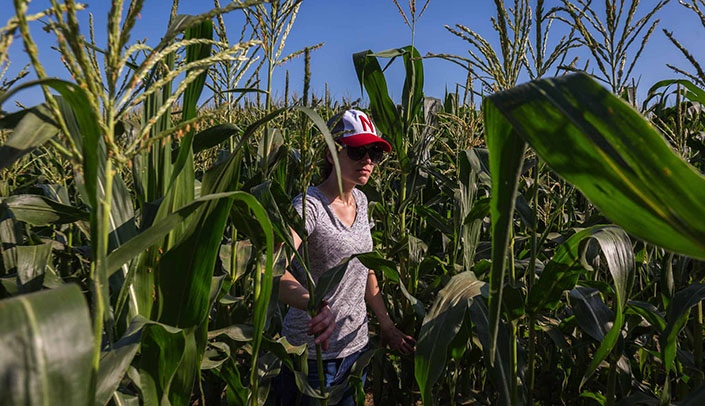More women than ever are actively engaged in farming operations across the United States.
In celebration of National Farm Safety and Health Week on Sept. 15-21, several organizations — such as the Central States Center for Agricultural Safety and Health (CS-CASH) at UNMC and the AgriSafe Network – will use the week to raise awareness of their expanding training resources focused on reducing the risk of injury and illness in women working in agriculture.
While noting that women have always played a role in working on the farm, Knesha Rose-Davison, health communications director for the AgriSafe Network, said the role of women in farming is growing. The 2017 U.S. Census estimates that 36% of all producers are female and 56% of all farms have at least one female decision maker.
“The numbers went from about 970,000 women actively working in farming operations in 2012 to around 1.2 million in 2017,” Rose-Davison said. “With this 27% spike in the numbers, we have a concern about the unique safety issues women face when they’re working on the farm.”
In 2017, AgriSafe Network began collaborating with CS-CASH to collect personal accounts of injury from women working in farm situations. Analyzing the data allowed them to identify specific types of injuries and high-risk activities that women are typically exposed to on the farm.
“Ergonomic issues are especially prominent for women,” Rose-Davison said. “Men experience ergonomic injuries, too. But due to their size and physical strength, women handling livestock or working at activities involving repetitive movements are prone to ergonomic injuries.”
Ergonomics is a science that helps improve products, processes and tools to help people work and live better and to prevent injury.
Injuries and strained muscles in the neck, shoulders and back are common in women. Ergonomic injuries can occur more readily as women age and bone density, chronic diseases, natural decline in strength and other physical changes occur.
“One of the training areas we’ve developed is a focus on ergonomics and having materials that focus on building core strength,” Rose-Davison said. “Most of us aren’t familiar with the muscles in our core that we often use in doing physical work. We’ve developed yoga and Pilates posters and will soon offer videos that explain what muscle groups we use for certain types of work. Understanding this will help women avoid straining those muscles, which can lead to injury.”
Women on the farm also are highly prone to injuries related to assisting with birthing animals.
“This is an especially high-risk activity if the woman herself is pregnant,” Rose-Davison said. “Assisting with a birthing of animals can result in exposure of pregnant women and their fetuses to disease and physical injury. It’s important for women to be aware of the risks they face in these scenarios and knowing how to protect themselves.”
Heavy lifting during any stage of pregnancy can affect an unborn fetus. Exposure to farm chemicals such as herbicides and pesticides also may put women at increased risk when they are pregnant.
Rose-Davidson said, “It’s common on the farm to jump in and get a job done without fully considering the safety risks you encounter in doing that job.”
Traditionally, women in leading roles on the farm have not had access to safety training resources customized to suit their unique needs, she said.
Because agriculture is one of the most dangerous occupations with multiple health threats, including threats to reproduction and ergonomics, AgriSafe will share training programs, which will be featured during National Farm Safety and Health Week.
